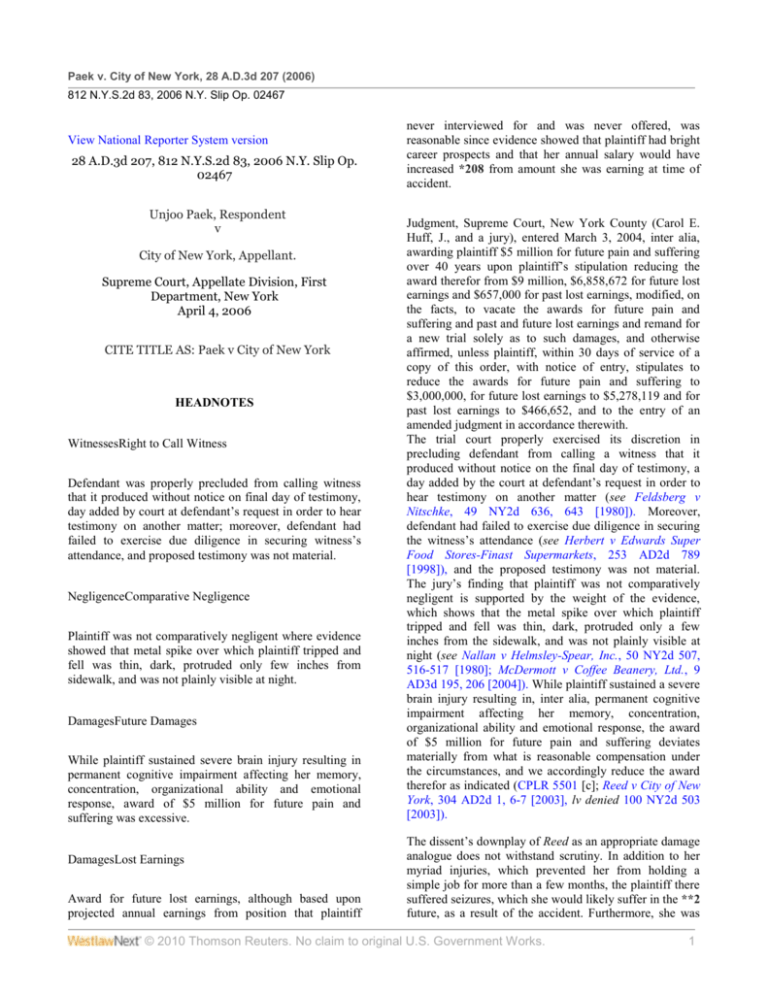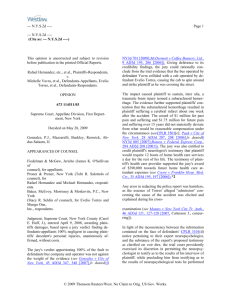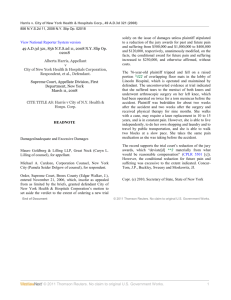Paek v. City of New York - New York Injury Cases Blog
advertisement

Paek v. City of New York, 28 A.D.3d 207 (2006) 812 N.Y.S.2d 83, 2006 N.Y. Slip Op. 02467 View National Reporter System version 28 A.D.3d 207, 812 N.Y.S.2d 83, 2006 N.Y. Slip Op. 02467 Unjoo Paek, Respondent v City of New York, Appellant. Supreme Court, Appellate Division, First Department, New York April 4, 2006 CITE TITLE AS: Paek v City of New York HEADNOTES WitnessesRight to Call Witness Defendant was properly precluded from calling witness that it produced without notice on final day of testimony, day added by court at defendant’s request in order to hear testimony on another matter; moreover, defendant had failed to exercise due diligence in securing witness’s attendance, and proposed testimony was not material. NegligenceComparative Negligence Plaintiff was not comparatively negligent where evidence showed that metal spike over which plaintiff tripped and fell was thin, dark, protruded only few inches from sidewalk, and was not plainly visible at night. DamagesFuture Damages While plaintiff sustained severe brain injury resulting in permanent cognitive impairment affecting her memory, concentration, organizational ability and emotional response, award of $5 million for future pain and suffering was excessive. DamagesLost Earnings Award for future lost earnings, although based upon projected annual earnings from position that plaintiff never interviewed for and was never offered, was reasonable since evidence showed that plaintiff had bright career prospects and that her annual salary would have increased *208 from amount she was earning at time of accident. Judgment, Supreme Court, New York County (Carol E. Huff, J., and a jury), entered March 3, 2004, inter alia, awarding plaintiff $5 million for future pain and suffering over 40 years upon plaintiff’s stipulation reducing the award therefor from $9 million, $6,858,672 for future lost earnings and $657,000 for past lost earnings, modified, on the facts, to vacate the awards for future pain and suffering and past and future lost earnings and remand for a new trial solely as to such damages, and otherwise affirmed, unless plaintiff, within 30 days of service of a copy of this order, with notice of entry, stipulates to reduce the awards for future pain and suffering to $3,000,000, for future lost earnings to $5,278,119 and for past lost earnings to $466,652, and to the entry of an amended judgment in accordance therewith. The trial court properly exercised its discretion in precluding defendant from calling a witness that it produced without notice on the final day of testimony, a day added by the court at defendant’s request in order to hear testimony on another matter (see Feldsberg v Nitschke, 49 NY2d 636, 643 [1980]). Moreover, defendant had failed to exercise due diligence in securing the witness’s attendance (see Herbert v Edwards Super Food Stores-Finast Supermarkets, 253 AD2d 789 [1998]), and the proposed testimony was not material. The jury’s finding that plaintiff was not comparatively negligent is supported by the weight of the evidence, which shows that the metal spike over which plaintiff tripped and fell was thin, dark, protruded only a few inches from the sidewalk, and was not plainly visible at night (see Nallan v Helmsley-Spear, Inc., 50 NY2d 507, 516-517 [1980]; McDermott v Coffee Beanery, Ltd., 9 AD3d 195, 206 [2004]). While plaintiff sustained a severe brain injury resulting in, inter alia, permanent cognitive impairment affecting her memory, concentration, organizational ability and emotional response, the award of $5 million for future pain and suffering deviates materially from what is reasonable compensation under the circumstances, and we accordingly reduce the award therefor as indicated (CPLR 5501 [c]; Reed v City of New York, 304 AD2d 1, 6-7 [2003], lv denied 100 NY2d 503 [2003]). The dissent’s downplay of Reed as an appropriate damage analogue does not withstand scrutiny. In addition to her myriad injuries, which prevented her from holding a simple job for more than a few months, the plaintiff there suffered seizures, which she would likely suffer in the **2 future, as a result of the accident. Furthermore, she was © 2010 Thomson Reuters. No claim to original U.S. Government Works. 1 Paek v. City of New York, 28 A.D.3d 207 (2006) 812 N.Y.S.2d 83, 2006 N.Y. Slip Op. 02467 found to be demented due to memory loss and an inability to perform thought-control functions. *209 Her experts agreed that her postaccident condition posed a risk of deteriorating into Parkinson’s and/or Alzheimer’s disease. The jury award of $9.275 million for brain injuries (Flynn v General Motors Acceptance Corp., 179 Misc 2d 555 [1998]), cited by the dissent, is hardly an exemplar for us on appellate review. The dissent justifies its reliance on Flynn on the ground that “the voice of the jury is the voice of the community, and it should not be so cavalierly ignored.” Of course, that is not the standard of appellate review. An award is excessive if it deviates materially from what would be reasonable compensation (see CPLR 5501 [c]). The standard for that determination is set by judicial precedent, not juries. The award for future lost earnings based upon projected annual earnings of $150,000 is speculative in view of evidence that plaintiff never interviewed for and was never offered the position that would have paid her that amount (cf. Cranston v Oxford Resources Corp., 173 AD2d 757, 758 [1991], lv denied 78 NY2d 860 [1991]). However, the evidence does show that plaintiff had bright career prospects and that her annual salary would have increased from the $75,000 she was earning at the time of the accident. Based upon the estimates provided by plaintiff’s economist, an award of $5,278,119 constitutes reasonable compensation for future lost earnings. The jury’s award for past lost earnings exceeds the $466,652 calculated by her own economist and otherwise lacks support, and we modify accordingly. Concur-Sullivan, Nardelli and Williams, JJ. Saxe, J.P., dissents in part in a memorandum as follows: I disagree with the majority’s further reduction of the verdict for future pain and suffering. Plaintiff suffered a devastating traumatic brain injury, resulting in multiple life-altering cognitive impairments. The jury’s award of $9 million for future pain and suffering was appropriate to the particular circumstances, and certainly, the award as reduced by the trial court to $5 million cannot be said to deviate materially from what would be reasonable compensation under the circumstances. The jury in the present case awarded plaintiff $9 million over 40 years, based upon the particular facts of this plaintiff’s ruined life. Before the accident, she had been a highly skilled, sought-after pattern maker at Calvin Klein, a premier fashion house. But more than that, she had been a vital, creative, sociable, adventurous 35-year-old woman, who looked forward to the time when she could have a family and be a mother, which she said had been her true goal. She now suffers significant cognitive deficits affecting her memory, organizational ability, attention span and concentration, as well as a mood disorder *210 marked by severe depression, and is in constant pain from persistent headaches. Her entire life has been stunted in all its essentials. The jury heard testimony that plaintiff will never be able to return to work, or engage in any type of meaningful employment. Her treating neurologist made a diagnosis of dementia based upon the constellation of plaintiff’s symptoms, which includes confusion, disorganization, inability to plan, inability to carry out activities of daily life, and memory difficulties with respect to verbal information. She has trouble completing simple tasks, and cannot balance a checkbook or cook. Her fundamental personality has changed: she is nervous, anxious, depressed, and, importantly, her dream of having a family is unrealizable. As she explained during her **3 testimony, “I cannot take care of myself. How can I take care of a baby?” These sad circumstances, as well as the jury’s conclusion that plaintiff’s future pain and suffering award was intended to cover a period of 40 years, support the conclusion that the verdict for future pain and suffering reached by the jury in this matter constitutes reasonable compensation. In concluding that the trial court’s award of $5 million for future pain and suffering deviates materially from what is reasonable compensation under the circumstances, the majority cites Reed v City of New York (304 AD2d 1, 6-7 [2003], lv denied 100 NY2d 503 [2003]). That case also concerned a plaintiff who suffered brain damage with similar deficits in cognitive functions; the jury there, based upon what it heard as to that particular plaintiff’s life, awarded $2.5 million for future pain and suffering over 30 years, an award affirmed by this Court. But that finding as to the value of that particular plaintiff’s expected future pain and suffering does not require that any future plaintiff suffering a similar injury should be limited to a similar sum. While the injury here was similar to that suffered by the plaintiff in Reed, the proven effects of the injury on the respective plaintiffs’ lives were different. In Reed there was no indication that the plaintiff had been engaged in an ambitious or personally rewarding career, nor that she had harbored a “true goal” of motherhood that her injuries now precluded. Further, in Reed the term of future pain and suffering was set at 30 years, rather than the 40-year period found by the jury here. Therefore, even when comparing this case to the Reed case for purposes of determining reasonable compensation for the injury, the award for future pain and suffering for a 40-year period, given these circumstances, cannot be fairly said to materially *211 deviate from what is reasonable compensation by comparing it to Reed. Another case in which a similar injury was considered and a similar award made is Flynn v General Motors Acceptance Corp. (179 Misc 2d 555 [1998]). There, the plaintiff was a young honor graduate of Smith College, whose brain injuries had a profoundly negative impact upon her personal and professional life, including marked personality changes. The jury awarded that plaintiff © 2010 Thomson Reuters. No claim to original U.S. Government Works. 2 Paek v. City of New York, 28 A.D.3d 207 (2006) 812 N.Y.S.2d 83, 2006 N.Y. Slip Op. 02467 $9.275 million for future pain and suffering for 55 years. While the matter was ultimately not presented for appellate review, the jury’s finding as to the value of the injury is of substantial relevance in assessing the reasonableness of the verdict here. The majority seems to suggest that the award of damages that we affirmed in Reed set in stone a line of demarcation. I do not seek to downplay Reed as the majority suggests. Instead, I merely seek to analyze the result in Reed in the context of the facts presented there, and the award in the present case in view of the facts presented here. As the Court of Appeals recognized in Caprara v Chrysler Corp. (52 NY2d 114, 127 [1981]), “[i]n no two cases are the quality and quantity of such damages identical.” While we look to similar cases to determine whether an award deviates materially from what would be reasonable compensation, this reference to similar cases was never intended to require that the awards in prior cases set the limit for awards in future similar cases. Having engaged in the process of comparing and contrasting the respective facts in this case with those in Reed, I find that the jury award, as reduced by the trial court, does not materially deviate from what would be fair and reasonable compensation. 555 [1998], supra) as “hardly an exemplar for us on appellate review,” it offers no critical analysis of the extent of injury in that case and its impact on the future loss of enjoyment of life of that plaintiff. Of course, jury damage verdicts are not controlling on us in our oversight role as gatekeepers under CPLR 5501 (c), but I disagree with the majority’s assertion that only judicial rulings reviewing **4 jury awards are of any relevance in determining what is fair and reasonable compensation. This declaration of the complete irrelevance of jury awards is unnecessarily extreme. The voice of a jury is the voice of the community, and it should not be so cavalierly ignored when deciding whether an award deviates materially from what would be reasonable compensation. Indeed, not only are jury awards of relevance in deciding *212 what is reasonable, but in some circumstances they may offer the only basis for comparison. Since in similar cases amounts were awarded which were comparable to this one, once essential differences in the circumstances in each case are accounted for, I would affirm the trial court’s determination as to future pain and suffering. Copr. (c) 2010, Secretary of State, State of New York While the majority disparages reference to the $9.275 million jury verdict to the brain-damaged plaintiff in Flynn v General Motors Acceptance Corp. (179 Misc 2d End of Document © 2010 Thomson Reuters. No claim to original U.S. Government Works. © 2010 Thomson Reuters. No claim to original U.S. Government Works. 3



![[2012] NZEmpC 75 Fuqiang Yu v Xin Li and Symbol Spreading Ltd](http://s3.studylib.net/store/data/008200032_1-14a831fd0b1654b1f76517c466dafbe5-300x300.png)

